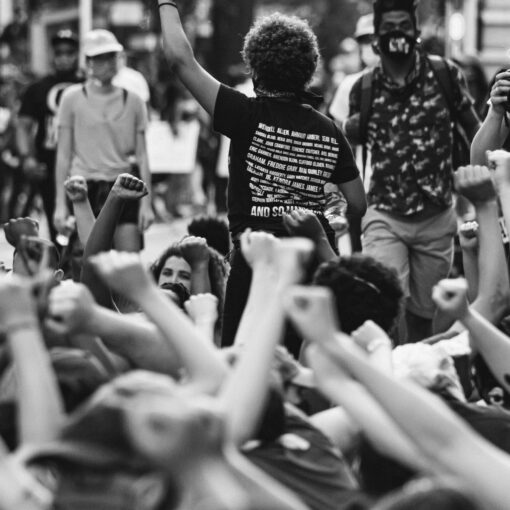This is the second post in a three-part series by PhD student and Mellon Humanities Public Fellow Daniel Valtueña about his experience of curating the project En un cuartito los dos in the James Gallery at The Graduate Center, City University of New York.
Post 1: What More Could a Final Paper Do?
Post 3: Beyond Academic Collaboration

Academics are constantly quoting. We are used to drawing on what has been said in our respective fields in order to legitimate innovative arguments. Quoting works as a complex system of power wherein scholars position themselves in relation to others who have come before; this legitimates our own work and limits our vulnerability to criticism.
This is how the production of knowledge has traditionally worked in the academy. The question is: is this the only way (or even the best way) for it to be?
In the framework of En un cuartito los dos, I organized and moderated a round-table discussion under the title Towards a Desanctification of the Gallery Space. In the James Gallery at The Graduate Center, artist Niño de Elche, curator Regine Basha, and architect Lluís Alexandre Casanovas Blanco discussed how little has been done in relation to performance practices in the gallery space. This interdisciplinary discussion aimed to create a space for debate but also an opportunity to diagnose the limits of performance within commodified spaces and to propose ideas for the future.
In his remarks, Casanovas emphasized how New York City is always reimagining performance spaces without really creating venues for practices to significantly change. He argued that a constant repetition of practices crystalizes ideas that become hard to question––they seem to naturally belong to our understanding of the world. This type of “quoting” assimilates concrete practices as part of a certain reality. Social norms and official rules dictate ways of doing that exclude practices that become hard to imagine––such as eating in an exhibition or “watching” a concert half the audience can’t actually see.
The recent opening of the performance space The Shed at Hudson Yards, for instance, inaugurated a pretty conservative slate of programming that didn’t challenge NYC audiences at all. Björk’s concert last season, for example, didn’t bring any radical changes to the scene. Instead, it quoted recurrent ideas that her devoted public was willing to pay for. In contrast, Regine Basha showed us how her curatorial project Tuning Baghdad aimed to reimagine the interactions between a given space and the audience by presenting an audiovisual collection from the Iraqi-Jewish music scene in a site-specific tea salon. Rather than constantly repeating the same lines for the comfort and pleasure of her audience, Basha aimed to reformulate what gallery spaces are meant to be.

Along these same lines, artist Niño de Elche underscored how it is not exclusively up to the artist but to the audience to reimagine the possibilities of architectural spaces regarding performance art. In fact, Niño de Elche’s performance the next day at the James Gallery demonstrated how an audience’s behavior is absolutely fundamental for the specificity of the artistic experience. He and I tried to anticipate and guide the audience through the space but there were certain reactions we didn’t anticipate at all: some audience members clapped when he played the guitar; others enjoyed the sound instead of watching him, confronting the experience as an art installation rather than a performance; still others were quite shy about getting too close to the artist. For me, facilitating a venue and performance that deliberately confused the audience meant calling on unknown referents rather than the conventional ones people might feel more comfortable with.
The conversation with Casanovas, Niño de Elche, and Basha resonated deeply––and unexpectedly––with my practice as an academic. As a scholar, I would like to create similarly unexpected moments within my writing, but the rigid system of quoting doesn’t make that easy. Just as performance art constantly draws on traditional artistic principles that limit its possibilities, quoting in academic writing both legitimates and limits what a scholar––especially a young scholar like myself––can say.
Quoting others is a fundamental research practice that helps position a piece in relation to the work that came before it. However, my experience in working with performance artists has shown me how much can be gained by questioning and disrupting fundamental practices and conventions. Quoting often limits our public voices as scholars by propping us up on the shoulders of others––it’s a form of academic “collaboration” that takes very little risk. However, I believe scholars might surrender some of the legitimation and safety quoting offers in favor of boundary-crossing innovations which might be riskier–– but also more generative.
Daniel Valtueña thanks Stacy Hartman and Anthony J. Harb for their writing advisement on this text.
 Daniel Valtueña is a PhD student in the Department of Latin American, Iberian, and Latino Cultures. He earned his BA in Art History at Universidad Complutense de Madrid and his research focuses on contemporary Iberian cultures and queer theories. His work explores the notion of celebration from both theoretical and curatorial perspectives, and his dissertation will address contemporary Iberian artistic practices in the intersection of queer and national identities. In 2012 he was awarded the Certamen Nacional Jóvenes Investigadores by the Spanish Government for his early research initiatives and received the Premio Talento Joven in the category of Culture by the Madrid Region in 2015 for his arts management trajectory. Daniel is also a curator based in New York and Madrid. Follow him on Instagram at @danielvaltuena.
Daniel Valtueña is a PhD student in the Department of Latin American, Iberian, and Latino Cultures. He earned his BA in Art History at Universidad Complutense de Madrid and his research focuses on contemporary Iberian cultures and queer theories. His work explores the notion of celebration from both theoretical and curatorial perspectives, and his dissertation will address contemporary Iberian artistic practices in the intersection of queer and national identities. In 2012 he was awarded the Certamen Nacional Jóvenes Investigadores by the Spanish Government for his early research initiatives and received the Premio Talento Joven in the category of Culture by the Madrid Region in 2015 for his arts management trajectory. Daniel is also a curator based in New York and Madrid. Follow him on Instagram at @danielvaltuena.







